Effective Dirac Neutrino Mass Operator in the Standard Model With a Local Abelian Extension
- Instituto de Física, Universidad de Antioquia, Calle 70 No. 52-21, Medellín, Colombia
We present 48 types of solutions to the anomaly cancellation conditions of local Abelian extensions of the Standard Model (SM) with right-handed SM-singlet chiral fermions. At least two of them acquire effective light Dirac neutrino masses, while the others get heavy masses from the spontaneous symmetry breaking of the local Abelian symmetry, forming a dark sector with multi-component and multi-generational fermionic dark matter. The corresponding effective Dirac neutrino mass operator can be realized at tree-level or radiatively by introducing extra scalars, and in some cases after imposing extra scotogenic conditions. The Dirac Zee model with Dirac fermionic dark matter is presented as an example of model where the neutrino and dark matter phenomenology are basically independent of each other.
1 Introduction
We can relate fermionic dark matter (DM) with neutrinos in two ways, through the fermions inside the loops in scotogenic models [1] or through anomaly-free gauge extensions of the SM with the extra chiral fermions required to cancel out the anomalies [2]. With Dirac neutrinos, we can have the two ways simultaneously. In fact, regarding neutrinos, the oscillation data is compatible with both Majorana or Dirac neutrino masses. To explain Dirac neutrino masses, right-handed neutrinos have to be introduced. Additionally, an extra local symmetry is also required to guarantee proper total lepton number conservation. Moreover, to have a consistent anomaly-free local symmetry, extra right-handed SM-singlet chiral fields are required in a dark sector which may include dark matter candidates.
In this work we propose a general framework for the systematic study of Dirac neutrino masses in the context of a gauge Abelian symmetry with multi-component dark matter and massive gauge bosons, including the possibility of dark photons.
By using an effective operator approach with up to 10 extra SM-singlet chiral fields, we found a well defined set of 48 types of solutions with effective Dirac neutrino masses, multi-component and multi-generational dark matter, and either a dark photon or a heavy gauge boson mediator.
It is worth noticing that the types of solutions comprise around one thousand specific charge assignments, each one constituting a self-consistent model with its own phenomenology worth to be analysed by itself. In fact, the phenomenology of some of them has been already studied in the literature (see [3, 4] and references therein). Concerning the realization of effective Dirac neutrino mass operator, it can always be realized at least within scalar extensions of each model, like the tree-level Type-II Dirac seesaw [4] or the Dirac Zee model [5], which do not affect the anomaly cancellation conditions at all.
This work is organized as follows. The anomaly conditions for the gauge Abelian symmetry are presented in Section 2, and expressed in terms of the charges of a set of right-handed SM-singlet chiral fields. In Section 3, a subset of them are used as the right-handed neutrino component of the effective Dirac neutrino mass operator. Then, the charge of the complex SM-singlet scalar that breaks spontaneously the gauge Abelian symmetry is fixed. In Section 4 we search for the solutions in which the remaining subset of right-handed SM-singlet chiral fermions obtain heavy masses from the SM-singlet scalar vacuum expectation value. There, they are classified in 48 types of solutions and their main features are highlighted. In Section 5 the solution with the least number of chiral fields is discussed and used as an example of the realization of the effective Dirac neutrino mass operator through SM scalar extensions. Finally, in Section 6 our conclusions are presented.
2 Anomaly Conditions
We consider an extension of the SM with an additional Abelian gauge symmetry and extra right-handed chiral fields singlets under the SM SU(3)c ⊗ SU(2)L ⊗ U (1)Y group. We assume that they do not form vector-like pairs so that all of them are massless before the spontaneous symmetry breaking of the Abelian gauge symmetry. On the other hand, we consider a set of N integers, n1, n2, … , nN, which satisfy the following Diophantine equations
In [3] it is shown that.
• The extra gauge Abelian symmetry can be identified as one dark symmetry, U (1)D, with Nchiral = N right-handed SM-singlet chiral fermions with D-charges n1, n2, … nN.
• The full set of anomaly cancellations conditions for the SM model can be rewritten just as Eq. 1. In fact, if the set of integers in Eq. 1 has one integer, m, repeated three times, the extra gauge Abelian symmetry can be identified as one active symmetry, U (1)X, with Nchiral = N − 3 right-handed SM-singlet chiral fermions with X-charges
where h is the SM Higgs X-charge, and Q is the X-charge of the conjugate of the SM quark doublet. If in addition we choose L such that h = 0, then we obtain the well known U (1)B−L symmetry, while if we choose L = 0 we obtain a symmetry where the SM fermion doublets are neutral, U (1)R [6].
We are interested in chiral solutions: the ones in which there is no D or X opposite sign charges for the right-handed chiral fermions. This is motivated by the fact that there are only chiral fermions in the SM.
The simple solution to obtain an active symmetry, U (1)X, is just to have m = 1 and three right-handed SM-singlet chiral fermions. When h = 0, such that L = 1, this is the well known U (1)B−L set of N integers satisfying Eq. 1 (−1,−1,−1, 1, 1, 1), and any multiplicative factor of it (−m,−m,−m, m, m, m)2. Note that we can make the direct sum of this simple solution with any other solution with Nchiral integers that does not contains m, to obtain an active gauge Abelian symmetry with three extra right handed chiral fermions with X-charges −m [4]. The same procedure can be used to obtain active symmetries for any chiral solution of Eq. 1, by identifying a subset of its integers as m. For example, from the well known solution (1, 1, 1,−4,−4, 5) [7, 8] of Eq. 1, we can build the following extra active solutions with their corresponding m
Finally, for any given solution, we also have a new solution from the direct sum with itself. For example
In the next section we will apply phenomenological conditions upon all the solutions with 5 ≤ N ≤ 12 integers obtained with the method explained in [9] and implemented in the python package anomalies [10] 3. The corresponding dataset with 390,074 solutions to Eq. 1, with a maximum absolute value of 30, is in [11]. They are complemented with the direct sums as in Eqs. 3, 4 for each solution while keeping the maximum number of integers less or equal than 12.
3 Effective Dirac Neutrino Mass Operator
In this section, we look for anomaly-free Abelian gauge extensions of the SM, with right-handed SM-singlet chiral fermions, realizing the effective Dirac neutrino mass operator at a given dimension [12, 13]. In the two-component spinor notation, this can be written as
and δ = 1, 2, … for dimension d = 4 + δ operators. Here
Finally, Λ is a scale of new physics.
In general, after the SSB, several discrete symmetry are left, which may guarantee the stability of at least one potential DM candidate [14]. m ≠ 0 define an active symmetry where the collider restrictions on Z′ are rather strong because its allowed couplings to both light quarks and light leptons, while m = 0 corresponds to a dark symmetry with the corresponding dark photon.
The tree-level realization of the renormalizable operator for Dirac neutrino masses through the Higgs mechanism is obtained when δ = 0, such that ν = −m. Therefore, it is only possible for active symmetries. The simple realization is for the U (1)B−L solution (−1,−1,−1, 1, 1, 1) with m = 1, ν = −1, and s = 3 to avoid a Majorana mass for νR. Therefore, the remnant Z3 symmetry guarantees the Diracness of the tree-level neutrino masses. However, such a solution imply very tiny Yukawa coupling
For δ > 0 we can have tree-level [4] or radiative [3] realizations of the non-renormalizable effective Dirac neutrino mass operator. The specific realization can imply additional phenomenological conditions besides Eq. 6 [3]. However, there are realizations that only involve extra scalars beyond the SM [15] which do not affect the anomaly cancellation conditions. Therefore, any found solution satisfying Eq. 6 can be embedded into a SM scalar extension which realize the effective Dirac neutrino mass operator, like the tree-level Type-II Dirac seesaw [4]. In this way, we can focus into find the self-consistent solutions with at least two repeated charges, ν, which are compatible with the effective Dirac neutrino mass operator (5). This self-consistent solutions are defined such that the only particles beyond the SM are νRα, S and the set of SM-singlet chiral fermions which acquires masses from ⟨S⟩ and that can play the role of (multi-component) dark matter. The solutions up to N = 9 were already found in [4] in the context of type-II Dirac seesaw realizations of the effective Dirac neutrino mass operator for δ = 1. Here, we extend the search of self-consistent solutions in the more general framework of the effective operator up to N = 12 and all the relevant values for δ.
4 Dark Sector With Multi-Component and Multi-Generational Dark Matter
Starting from the extended dataset for the solutions with N integers to the Diophantine Eq. 1, we apply the following steps.
• Check that the solution has two (three) repeated integers to be identified as ν and fix Nν = 2 (Nν = 3).
• For δ = 1, 2, … and all the possible combinations for m and ν in the solution, including m = 0, find the s value compatible with the effective Dirac neutrino mass operator of d = 4 + δ according to Eq. 6.
• Interpret the integers in the solution that are different from m and ν as the D-charges for m = 0 or the X-charges for m ≠ 0, of a set of SM-singlet chiral fermions: ψi, i = 1, … , Nchiral − Nν. Then select the solutions for which the condition
which guarantees that all the SM-singlet chiral fermions, ψi, acquire masses after the spontaneous symmetry breaking of the gauge Abelian symmetry through ⟨S⟩.
We found 1 122 solutions where all the SM-singlet chiral fermions have either one effective mass through the operator in Eq. 5 or from the vacuum expectation value of S after the spontaneous symmetry breaking of either the dark or the active Abelian gauge symmetry. As shown in Figure 1, most of the solutions are for δ = 1 and N = 10.
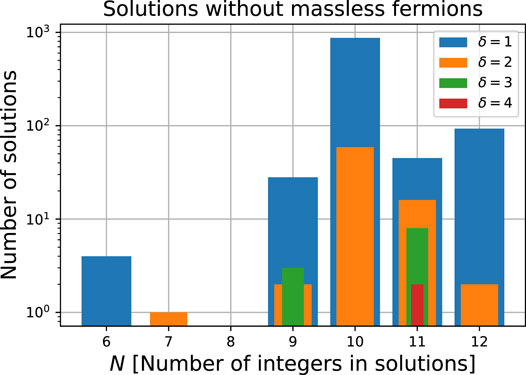
FIGURE 1. Distribution of solutions with N integers to the Diophantine Eq. 1 which allow the effective Dirac neutrino mass operator at d = (4 + δ) for at least two right-handed neutrinos and have non-vanishing Dirac o Majorana masses for the other SM-singlet chiral fermions in the solution.
Concerning the solutions with multi-component DM, we also explore the cases which feature at least two DM candidates with unconditional stability [4, 16]. This happens when the remnant symmetry
•
•
where ω|s| = ei 2π/|s|.
The solutions can be classified in 48 types depending on the dimension of the effective Dirac neutrino mass operator, d = (4 + δ), for δ = 1, 2 values 4; the number of Dirac or Majorana massive SM-singlet fermions; the multiplicity of generations for each one of them; and the unconditional stability of at least two of the multi-component dark matter candidates. The most representative solutions (with the lower possible maximum charge) for each type, are presented in Table 1. The column m there, label the solutions of Eq. 1 which are interpreted as one dark symmetry as a solution with m = 0 (absence of m), and the ones with three repeated integers to be interpreted as an active symmetry, as a solution with m ≠ 0 (identified m). Note that the dark symmetry solution in the third row of Table 1 could be also identified as an active symmetry with m = −7.
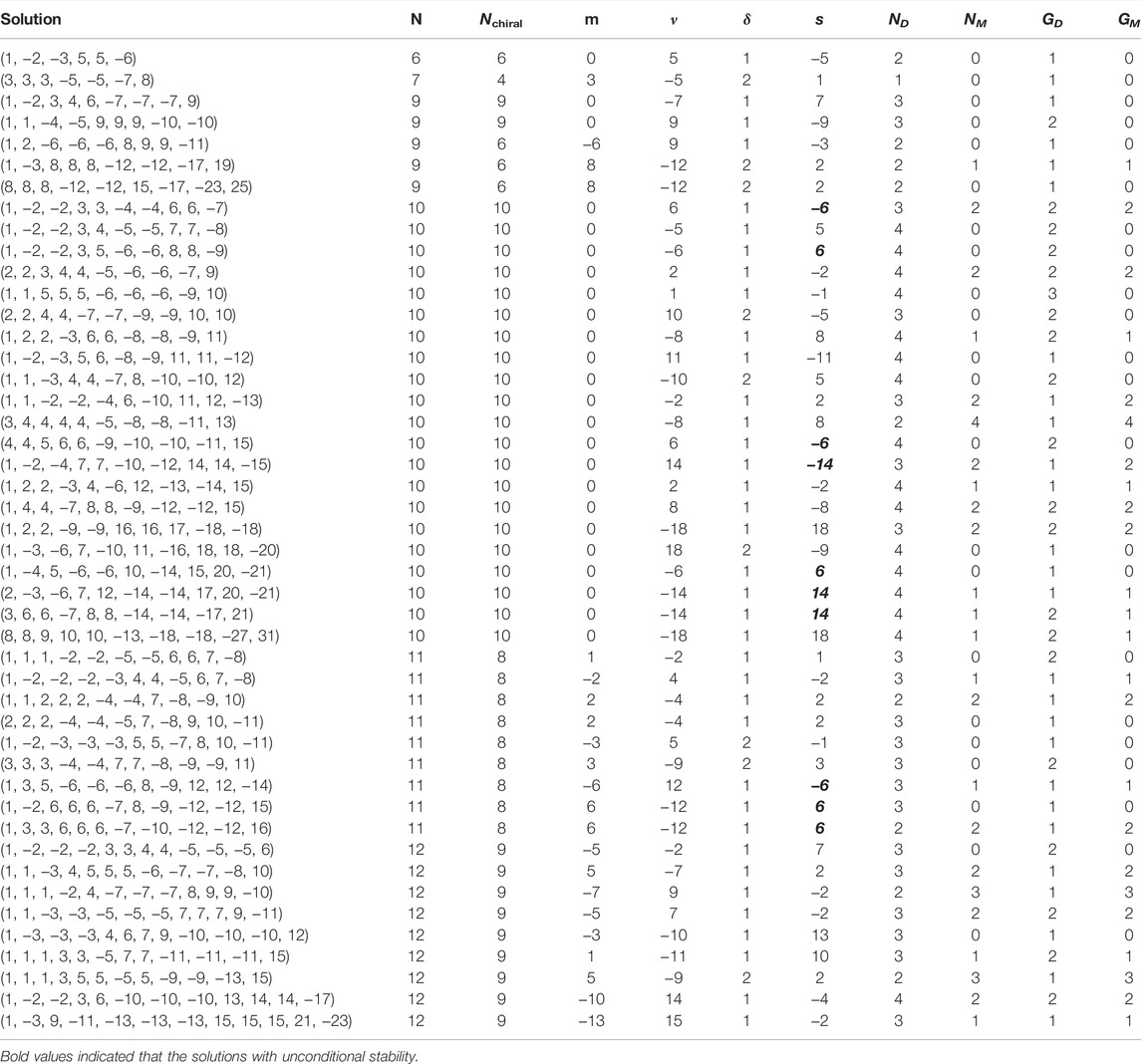
TABLE 1. Set of charges satisfying the Diophantine Eq. 1 together with the conditions enumerated in the text, for solutions with Nchiral massive fermions, including the Dirac neutrinos masses allowed by the effective operator of d = 4 + δ, the solution with unconditional stability through
In this way, in Table 1, the list of N integers in column “Solution” satisfy the Diophantine Eq. 1 for an active symmetry if m ≠ 0 or for a dark symmetry if m = 0 (in such a case the number of new SM-singlet chiral fermions is increased by 3). In each solution there are Nchiral SM-singlet chiral fermions, from which Nν can develop effective Dirac neutrino masses from the operator in Eq. 5 with d = 4 + δ. The remaining SM-singlet chiral field acquires Dirac or Majorana masses from the Yukawa couplings with the complex SM-singlet scalar, S. Finally, the solutions with unconditional stability are highlighted with a bold font in the column s of Table 1. The last four columns correspond to the number of massive Dirac (Majorana) fermions ND (NM) and the maximum number of generations for the Dirac (Majorana) fermions GD (GN) in each solution.
There are not types of solutions with a single massive Dirac or Majorana SM-singlet fermion in several generations: NDM = 1 and GDM > 1, which would point out to a pure scotogenic realization of the Dirac neutrino mass operator without extra fermionic DM candidates. In fact, in general, most of the solutions feature multi-component dark matter with the lighter of all them protected by at least one remnant discrete symmetry,
In Figure 2 it is illustrated the variety in which the number of Majorana and Dirac massive SM-singlet fermions appears in the several types of solutions. We can have types of solutions with up to four Majorana and two Dirac fermions for dark Abelian gauge symmetries of d = 5 (magenta discs) and four Dirac fermions and two Majorana ones for dark or active Abelian gauge symmetries of d = 5 (magenta and yellow discs respectively).
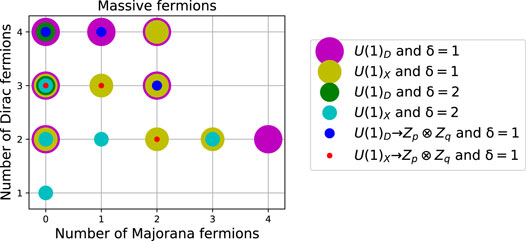
FIGURE 2. Number of massive Dirac and Majorana fermions of the full set of solutions in Figure 1. The discs magenta and green (yellow and cyan) are for dark (active) symmetries which allows the effective Dirac neutrino mass operator for at least two right-handed neutrinos for d = 4 + δ, with δ = 1, two respectively. Similarly, the blue and red points are the type of solution which satisfy the unconditional stability conditions for at least two DM candidates.
Each massive SM-singlet fermion can belong to a set of generations with the same quantum numbers but different masses. In Figure 3 it is shown the way in which each dark matter candidate is grouped in generations for the several types of solutions. From a phenomenological point of view, this is important because this allows to have the rank of the effective neutrino mass matrix sufficiently high in scotogenic realizations of Dirac neutrino mass operator [3]. Moreover, the interplay between several generations can boost the direct and indirect signals of the DM candidate [17]. We can have types of solutions with until four generations of Majorana SM-singlet fermions or with until three generations of Dirac SM-singlet fermions, for dark symmetries of d = 5 (magenta discs in the plot).
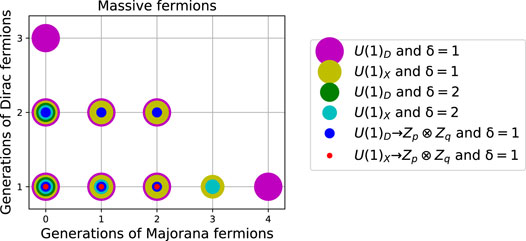
FIGURE 3. Same as Figure 2 but for number generations of massive Dirac and Majorana fermions of the full set of solutions in Figure 1.
Note also that dark symmetries with δ = 1 and unconditional stability, represented as blue dots in Figures 2, 3, are typically associated to a high number of massive SM-singlet Dirac fermions, Figure 2, in sectors of at most two generations of massive Dirac or Majorana SM-singlet fermions, Figure 3. On the other hand, active symmetries with δ = 1 and unconditional stability, represented as red dots in Figures 2, 3, are associated to at least two Dirac SM-singlet fermions and less than three Majorana SM-singlet fermions, Figure 2, without extra generations, Figure 3.
In any scotogenic realization of the effective Dirac neutrino mass operator, a set of the heavy SM-singlet fermions must participate directly in the generation of the light neutrino masses. In this way, the corresponding fermion Yukawa couplings are also constrained by neutrino physics. Extra conditions are required to check if a solution can have a scotogenic realization. In fact, all the solutions up to N = 9 for the one-loop scotogenic realization of the effective Dirac neutrino mass operator at d = 5 and d = 6 were presented in [3]. As an example, the solution in the first row of Table 1 was analyzed there, corresponding to one scotogenic realization of the d = 5 operator at one-loop through a dark symmetry with two independent Dirac fermionic dark matter candidates (magenta disc with coordinates (0, 2) in Figure 2). In general, for each type of solution we can have extra DM sectors which may be independent of the neutrino physics. It is worth noticing that in the absence of scotogenic conditions, the realization of the effective Dirac neutrino mass operator is always possible for SM extensions with only extra scalars at tree-level [4, 18], one-loop [15, 19] and two and three-loops [15]. Therefore, it is well motivated to make a systematic study of multi-component Dirac or Majorana fermionic DM, independent of the specific realization of the effective Dirac neutrino mass operator. Moreover, since the neutrino physics is in general independent of the DM phenomenology, we expect that the General Neutrino Interactions (GNI) can be large and well suited to be explored in neutrino experiments [19]. Additionally, the dark symmetry models contains a dark photon which can be searched in both neutrino and direct detection experiments. Alongside, the active symmetry contains a Z′ with both quark and lepton couplings which have strong dilepton signals at the LHC. It turns out that the Z′ portal also allows us to probe the models with m ≠ 0 through modifications of the cosmological history of the Universe, namely, via additional contributions from the right handed neutrinos to the effective number of relativistic degrees of freedom Neff, with constraints that are competitive with the ones obtained from colliders [20].
In general, we can see that multi-component and multi-generational DM candidates are the trend for gauge Abelian extensions of the SM with massive SM-singlet chiral fermions compatible with the effective Dirac neutrino mass operator of d = 4 + δ, for δ > 0.
5 Simplest Realization: Dirac Zee Model With Dirac Fermionic DM
As an illustration, consider the type of solution as the one in the second row of Table 1 (3, 3, 3, −5, −5, −7, 8). This features the one with the least Nchiral = 4, as summarized in Table 2. This solution is the simplest of the types of solutions with U (1)X and d = 6 (δ = 2), represented by the cyan dot with coordinates (0, 1) in Figures 2, 3.
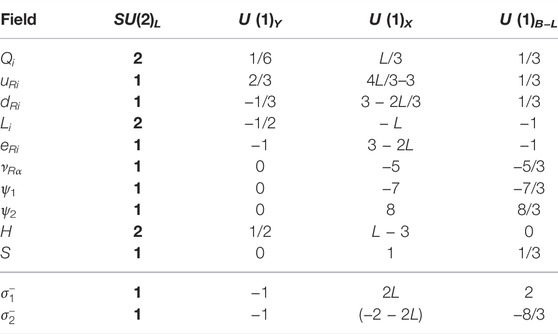
TABLE 2. X and proper B−L normalized charges for the first solution in Table 1 (3, 3, 3, −5, −5, −7, 8), for which m = 3, ν = −5, δ = 2 and therefore from Eq. 6, s = 1. For the column U (1)B−L we fix L = 3 and change X → X/3. Moreover, i = 1, 2, 3 and α = 1, 2. The electroweak quantum numbers are also shown for each one of SM fields, the extra SM-singlet chiral fermions, and the scalars in the last four rows.
The solution corresponds to an extension of the SM with m = 3 that for h = 0 give rise to a local U (1)B−L up to a global factor of − 1/3: u = d = −Q = 1 and e = −L = −3. This factor has been included in the column U (1)B−L of Table 2. The effective Dirac neutrino mass operator of d = 6 is compatible with two light Dirac neutrino masses through the right-handed neutrino, νR, with a (B− L)-charge of ν = −5/3. Without further conditions, this can be realized if we include two weak-singlet charged scalars, denoted as
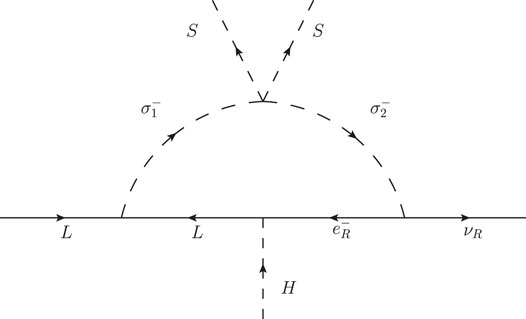
FIGURE 4. Diagram with the X-charge flux of the fields in the one-loop Dirac Zee model which realizes the effective Dirac neutrino mass operator at d = 6
In the new realization of the Dark Zee model presented here, we have the novelty that the model can also have a Dirac fermionic dark matter candidate. In fact, the Lagrangian includes a new Yukawa term
with two SM-singlet chiral fermions of (B− L)-charges −7/3 and 8/3 respectively. After the spontaneous symmetry breaking of the active gauge symmetry, this give rise to a Dirac heavy fermion mass
where
Therefore, in contrary to the scotogenic models, the DM phenomenology can be studied independently of the neutrino physics. And therefore, previous analysis of simplified dark matter models with Dirac fermionic dark matter in extensions of the SM with U (1)B−L, fully apply here. In particular, the annihilation cross section for
The corresponding spin-independent direct detection cross section of dark matter per nucleon is given by [21, 24].
where ψ1 = −7/3, ψ2 = 8/3 and L = 1, are the U (1)B−L charges in Table 2, and
is the reduced mass.
The cross section can be written as
We can illustrate the DM phenomenology for a specific benchmark point which is compatible with collider, ΔNeff [20] and the current direct detection currents constraints [25]. We choose gX = 0.1, MZ’ = 4 TeV, mS = 5 TeV. For this specific benchmark point, the main constraint arises from the current upper bound on ΔNeff for which MZ’ ≳ 40 TeV. This kind of constraint has the potential to probe the full model with the next generation of CMB experiments [20]. From Figure 5 we can see that the proper relic density can be obtained for MΨ ≈ 1840 GeV or MΨ ≈ 2050 GeV.
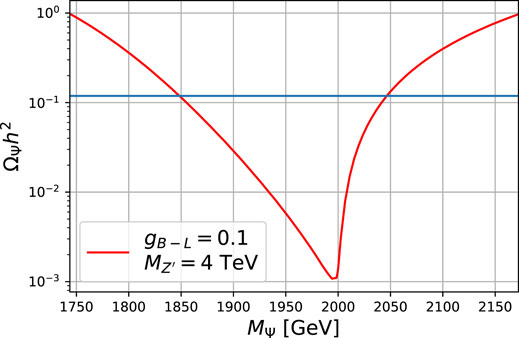
FIGURE 5. Dirac fermionic Dark matter relic density as a function of its mass for U (1)B−L with copuling gB−L = gX = 0.1, MZ’ = 4 TeV, mS = 5 TeV.
6 Conclusion
We found around one thousand solutions to the anomaly free conditions of local Abelian extensions of the SM with N integers and Nchiral right handed SM-singlet fermions which include the ones forming the effective set of Dirac neutrinos and a dark sector with massive fermions. We classify the solutions in 48 types in Table 1 depending if the symmetry is dark (Nchiral = N) or active (Nchiral = N − 3), the dimension of the effective Dirac neutrino mass operator (d = 4 + δ), the number of independent dark matter candidates, and the number of generations of each massive fermion. The scalar realizations of the effective Dirac neutrino mass operator feature a set of parameters which explain independently the neutrino oscillations and the phenomenology of a multi-component and multi-generational dark matter sector. This allows for large GNI and charged lepton flavor violation observables while keeping the features of the simplified dark matter models. We have illustrated this separation explicitly with a simple one-loop Dirac Zee model which has a Dirac fermionic dark matter candidate. We could expect enhanced effects in scalar realizations of the effective Dirac neutrino mass operator at two-loops and three-loops [15], which are not yet fully explored in the literature.
Data Availability Statement
The original contributions presented in the study are included in the article/Supplementary Material, further inquiries can be directed to the corresponding author
Author Contributions
All authors listed have made a substantial, direct, and intellectual contribution to the work and approved it for publication.
Funding
The work of DR is supported by Sostenibilidad UdeA, and the UdeA/CODI Grants 2017-16286 and 2020-33177.
Conflict of Interest
The authors declare that the research was conducted in the absence of any commercial or financial relationships that could be construed as a potential conflict of interest.
Publisher’s Note
All claims expressed in this article are solely those of the authors and do not necessarily represent those of their affiliated organizations, or those of the publisher, the editors and the reviewers. Any product that may be evaluated in this article, or claim that may be made by its manufacturer, is not guaranteed or endorsed by the publisher.
Supplementary Material
The Supplementary Material for this article can be found online at: https://www.frontiersin.org/articles/10.3389/fphy.2022.838531/full#supplementary-material
Footnotes
1Q and L are the X-charges of the fermion doublets Q† and L†, respectively.
2This solutions cannot be interpreted as a dark symmetry because it would contain three pairs of vector-like SM-singlet fermions.
3https://pypi.org/project/anomalies/.
4For larger δ there a few other solutions with similar features.
References
1. Ma E. Verifiable Radiative Seesaw Mechanism of Neutrino Mass and Dark Matter. Phys Rev D (2006) 73:077301. arXiv:hep-ph/0601225. doi:10.1103/physrevd.73.077301
2. Patra S, Werner R, Yaguna CE. A New B − L Model without Right-Handed Neutrinos. JHEP (2016) 09:076. arXiv:1607.04029 [hep-ph]. doi:10.1007/jhep09(2016)076
3. Bernal N, Calle J, Restrepo D. Anomaly-free Abelian Gauge Symmetries with Dirac Scotogenic Models. Phys Rev D (2021) 103:095032. arXiv:2102.06211 [hep-ph]. doi:10.1103/physrevd.103.095032
4. Bernal N, Restrepo D. Anomaly-free Abelian Gauge Symmetries with Dirac Seesaws. Eur Phys J C (2021) 81:11. arXiv:2108.05907 [hep-ph].
5. Nasri S, Moussa S. Model for Small Neutrino Masses at the TeV Scale. Mod Phys Lett A (2002) 17:771–8. arXiv:hep-ph/0106107. doi:10.1142/s0217732302007119
6. Jana S, Vishnu PK, Saad S. Minimal Dirac Neutrino Mass Models from $$\hbox {U}(1)_{\Mathrm{R}}$$ Gauge Symmetry and Left-Right Asymmetry at Colliders. Eur Phys J C (2019) 79:916. arXiv:1904.07407 [hep-ph]. doi:10.1140/epjc/s10052-019-7441-9
7. Appelquist T, Dobrescu BA, Hopper AR. Nonexotic Neutral Gauge Bosons. Phys Rev D (2003) 68:035012. arXiv:hep-ph/0212073. doi:10.1103/physrevd.68.035012
8. Montero JC, Pleitez V. Gauging U(1) Symmetries and the Number of Right-Handed Neutrinos. Phys Lett B (2009) 675:64–8. arXiv:0706.0473 [hep-ph]. doi:10.1016/j.physletb.2009.03.065
9. Costa DB, Dobrescu BA, Fox PJ. General Solution to the U(1) Anomaly Equations. Phys Rev Lett (2019) 123:151601. arXiv:1905.13729 [hep-th]. doi:10.1103/physrevlett.123.151601
11. Restrepo D. Set of N Integers between − 30 and 30 with Sum and Cubic Sum up to Zero for 4 < N < 13 (2021). doi:10.5281/zenodo.5526707
12. Cleaver G, Cvetič M, Espinosa JR, Everett L, Langacker P. Intermediate Scales, μ Parameter, and Fermion Masses from String Models. Phys Rev D (1998) 57:2701–15. arXiv:hep-ph/9705391. doi:10.1103/physrevd.57.2701
13. Gu P-H, He H-J. Neutrino Mass and Baryon Asymmetry from Dirac Seesaw. JCAP (2006) 2006:010. arXiv:hep-ph/0610275 [hep-ph]. doi:10.1088/1475-7516/2006/12/010
14. Batell B. Dark Discrete Gauge Symmetries. Phys Rev D (2011) 83:035006. arXiv:1007.0045 [hep-ph]. doi:10.1103/physrevd.83.035006
15. Saad S. Simplest Radiative Dirac Neutrino Mass Models. Nucl Phys B (2019) 943:114636. arXiv:1902.07259 [hep-ph]. doi:10.1016/j.nuclphysb.2019.114636
16. Yaguna CE, Zapata Ó. Multi-component Scalar Dark Matter from a ZN Symmetry: a Systematic Analysis. JHEP (2020) 2020:109. arXiv:1911.05515 [hep-ph]. doi:10.1007/jhep03(2020)109
17. Herms J, Ibarra A. Production and Signatures of Multi-Flavour Dark Matter Scenarios with T-Channel Mediators. J Cosmology Astroparticle Phys (2021) 2021(10):026. arXiv:2103.10392 [hep-ph]. doi:10.1088/1475-7516/2021/10/026
18. Ma E. Linkage of Dirac Neutrinos to Dark U(1) Gauge Symmetry. Phys Lett B (2021) 817:136290. arXiv:2101.12138 [hep-ph]. doi:10.1016/j.physletb.2021.136290
19. Calle J, Restrepo D, Zapata Ó. Phenomenology of the Zee Model for Dirac Neutrinos and General Neutrino Interactions. Phys Rev D (2021) 104:015032. arXiv:2103.15328 [hep-ph]. doi:10.1103/physrevd.104.015032
20. Calle J, Restrepo D, Zapata Ó. Dirac Neutrino Mass Generation from a Majorana Messenger. Phys Rev D (2020) 101:035004. arXiv:1909.09574 [hep-ph]. doi:10.1103/physrevd.101.035004
21. Duerr M, Perez PF, Smirnov J. Simplified Dirac Dark Matter Models and Gamma-Ray Lines. Phys Rev D (2015) 92:083521. arXiv:1506.05107 [hep-ph]. doi:10.1103/physrevd.92.083521
22. Staub F. SARAH 4: A Tool for (Not Only SUSY) Model Builders. Comput Phys Commun (2014) 185:1773–90. arXiv:1309.7223 [hep-ph]. doi:10.1016/j.cpc.2014.02.018
23. Bélanger G, Boudjema F, Goudelis A, Pukhov A, Zaldívar B. micrOMEGAs5.0 : Freeze-In. Comput Phys Commun (2018) 231:173–86. arXiv:1801.03509 [hep-ph]. doi:10.1016/j.cpc.2018.04.027
24. Duerr M, Perez PF. Theory for Baryon Number and Dark Matter at the LHC. Phys Rev D (2015) 91:095001. arXiv:1409.8165 [hep-ph]. doi:10.1103/physrevd.91.095001
Keywords: dark matter, neutrino, Dirac neutrino, Abelian gauge field, local symmetry breaking
Citation: Restrepo D and Suarez D (2022) Effective Dirac Neutrino Mass Operator in the Standard Model With a Local Abelian Extension. Front. Phys. 10:838531. doi: 10.3389/fphy.2022.838531
Received: 17 December 2021; Accepted: 10 March 2022;
Published: 26 April 2022.
Edited by:
Roberto A. Lineros, Catholic University of the North, ChileReviewed by:
Borut Bajc, Institut Jožef Stefan (IJS), SloveniaRoberto Martinez, National University of Colombia, Colombia
Eduardo Peinado, Universidad Nacional Autónoma de México, Mexico
Copyright © 2022 Restrepo and Suarez. This is an open-access article distributed under the terms of the Creative Commons Attribution License (CC BY). The use, distribution or reproduction in other forums is permitted, provided the original author(s) and the copyright owner(s) are credited and that the original publication in this journal is cited, in accordance with accepted academic practice. No use, distribution or reproduction is permitted which does not comply with these terms.
*Correspondence: Diego Restrepo, restrepo@udea.edu.co
 Diego Restrepo
Diego Restrepo David Suarez
David Suarez